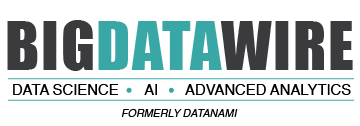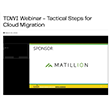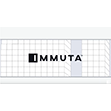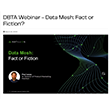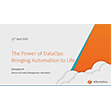
What Can Enterprises Learn From Genome Sequencing?
The data handing requirements for genetic discovery are increasing as the tools become more sophisticated, causing data sets to become increasingly large. However, dealing with these large data sets is nothing new for practitioners in traditional science, and enterprises can learn from the strategies and processes that these disciplines have put into play.
 Mario Caccamo, head of Bioinformatics at The Genome Analysis Center (TGAC) based in the UK, recently outlined the work and challenges that researchers face, explaining the explosive nature of the data and the processes that that genome scientists use to wrestle with it.
Mario Caccamo, head of Bioinformatics at The Genome Analysis Center (TGAC) based in the UK, recently outlined the work and challenges that researchers face, explaining the explosive nature of the data and the processes that that genome scientists use to wrestle with it.
“We have super exponential growth in data generation,” explained Caccamo. “To give you a concrete example, with two sequencing instruments in 2010, we generated 1.2 terabases of data. We can now generate half of that (600 gigabases) in two weeks in only one sequencing round with our current instruments.”
This, of course, is a familiar refrain that enterprise executives are hearing as they consider their own data plans and consider what their own data requirements will be down the line. But having an infrastructure to handle and store this data isn’t the same thing as having a strategy to turn it into predictive intelligence.
“This is very much hitting the point where you need a strategy to cope with more data today than you have ever generated before,” says Caccamo, explaining the growing challenges TGAC faces as their data volumes increase in size and complexity. The organization looks at these challenges holistically, explained Caccamo in describing how they have built a cultural infrastructure to support their data-driven science goals.
Caccamo explains that a technology focus drives their cultural underpinnings. “In one end, developing the state of the art intensive platform, both sequencing and computational – this is what I call the ‘hard infrastructure.’ The other focus of our activities is on what we can develop between intensive algorithms and databases – this is what we call the ‘soft infrastructure,’”
Caccamo explains that TGAC’s challenge is on developing these components together through what he calls a systems approach in order to produce “predictive assumptions” that help them towards discovery and ultimately understanding biology.
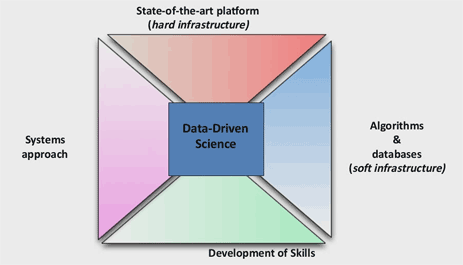
Included in their base equation is the development of skills, says Caccamo, being very sensitive to the talent acquisition challenges that organizations face in the exploding data science fields. “We really take training into this,” explained Caccamo. “Technologies and training toward developing new strategies and tools is a very important part of what we do.”
Putting this organizational foundation into place, explained Caccamo, they are then able to give focus to what their true aim is: data driven science. Their process is something that other organizations can learn from, suggests Caccamo, explaining TGAC’s view of the pipeline that starts with data on the input end, and biology science as the output.
The process starts with huge volumes of sequencing data and using efficient algorithms to tackle the data, endeavor to distill it into what can then be classified as “information.” In the case of genomic research, the information are the ~150 letter base strings that the researchers use to assemble genome maps with. The research head says that once they have achieved the information step in the process, the focus, they shift priorities from efficiency to quality. At this step, says Caccamo, they’re focused on turning “information” into “knowledge” which can then be transformed into biology.
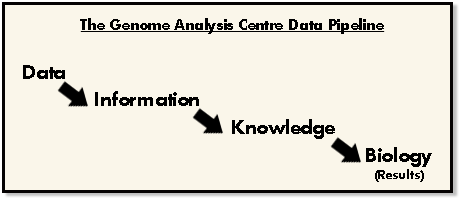
In the case of genome sequencing, the research head used the discovery process of the wheat genome as an example. The first step is in extracting and sequencing the DNA into strands of information called “bases,” which are ready for assembling into something more actionable.
These bases are then passed through sophisticated hardware (TGAC uses an array of SGI UV supercomputers for much of their assembly work) and assembled into enormous graphs. When mapped out in a graph, wheat has 10 billion nodes of sequencing information, says Caccamo. These graphs are now considered knowledge that can be used by biologists use for the purposes of obtaining better crops.
Caccamo explains that having the right strategy in place is essential for the long term success of TGAC because their data growth is exponential. He notes that as the data becomes cheaper and cheaper to process, the scope of the research tends to expand. In the example of wheat genetics, he explains that the research has expanded to examine environmental factors.
“A recent addition of the toolkit of the bioinformatician is that we can look now into what is present as well in the soil,” says Caccamo. “In this case, it’s not going to be about one species, but instead about a community of species – what we call a microbial community. That’s what we call metagenomics.”
While the concept of metagenomics is contained within the esoteric domain of the genomic community, the concept of the run-away project is not. Virtually every enterprise has experienced the resource drain that happens when a project expands beyond its original scope. In the case of big data, these run-away project can be very costly if there aren’t strategies in place to govern the direction they take.
As enterprises ramp up their big data initiatives, TGAC’s example suggests that organizations would be wise to consider the culture and processes already in place where traditional sciences have already blazed a trail in managing and processing enormous amounts of data.
Related Items:
Boosting Big National Lab Data
Intel CIO’s Big Data Prescription
February 18, 2025
- Boomi Unveils Comprehensive API Management to Combat Sprawl and Power Agentic AI
- Grid Status Launches Power Market Datasets on Snowflake Marketplace
- Gartner Predicts 40% of AI Data Breaches Will Arise from Cross-Border GenAI Misuse by 2027
- Fortanix Releases 2025 State of Data Security in GenAI Report
- Vultr Announces Availability of AMD Instinct MI325X GPUs to Power Enterprise AI
- SiMa.ai Advances Edge AI with Efficient Implementation of DeepSeek R1 Model
February 14, 2025
- Clarifai Unveils Control Center for Enhanced AI Visibility and Decision-Making
- EDB Strengthens Partner Program to Accelerate Postgres and AI Adoption Worldwide
- Workday Introduces Agent System of Record for AI Workforce Management
- Fujitsu Unveils Generative AI Cloud Platform with Data Security Focus
- NTT DATA Highlights AI Responsibility Gap as Leadership Fails to Keep Pace
- Gurobi AI Modeling Empowers Users with Accessible Optimization Resources
February 13, 2025
- SingleStore Unveils No-Code Solution Designed to Cut Data Migration from Days to Hours
- Databricks Announces Launch of SAP Databricks
- SAP Debuts Business Data Cloud with Databricks to Turbocharge Business AI
- Data Science Salon Kickstarts 2025 with DSS ATX Conference, Featuring AI Startup Showcase
- Hydrolix Achieves Amazon CloudFront Ready Designation
- Astronomer Launches Astro Observe to Unify Data Observability and Orchestration
- EU Launches InvestAI Initiative to Build AI Gigafactories Across Europe
- HPE Announces Shipment of Its First NVIDIA Grace Blackwell System
- OpenTelemetry Is Too Complicated, VictoriaMetrics Says
- What Are Reasoning Models and Why You Should Care
- Three Ways Data Products Empower Internal Users
- Keeping Data Private and Secure with Agentic AI
- Memgraph Bolsters AI Development with GraphRAG Support
- Three Data Challenges Leaders Need To Overcome to Successfully Implement AI
- Top-Down or Bottom-Up Data Model Design: Which is Best?
- PayPal Feeds the DL Beast with Huge Vault of Fraud Data
- Inside Nvidia’s New Desktop AI Box, ‘Project DIGITS’
- Data Catalogs Vs. Metadata Catalogs: What’s the Difference?
- More Features…
- Meet MATA, an AI Research Assistant for Scientific Data
- AI Agent Claims 80% Reduction in Time to Complete Data Tasks
- DataRobot Expands AI Capabilities with Agnostiq Acquisition
- Collibra Bolsters Position in Fast-Moving AI Governance Field
- Snowflake Unleashes AI Agents to Unlock Enterprise Data
- Observo AI Raises $15M for Agentic AI-Powered Data Pipelines
- Anaconda’s Commercial Fee Is Paying Off, CEO Says
- Microsoft Open Sources Code Behind PostgreSQL-Based MongoDB Clone
- Confluent and Databricks Join Forces to Bridge AI’s Data Gap
- Mathematica Helps Crack Zodiac Killer’s Code
- More News In Brief…
- Informatica Reveals Surge in GenAI Investments as Nearly All Data Leaders Race Ahead
- Gartner Predicts 40% of Generative AI Solutions Will Be Multimodal By 2027
- PEAK:AIO Powers AI Data for University of Strathclyde’s MediForge Hub
- DataRobot Acquires Agnostiq to Accelerate Agentic AI Application Development
- TigerGraph Launches Savanna Cloud Platform to Scale Graph Analytics for AI
- EY and Microsoft Unveil AI Skills Passport to Bridge Workforce AI Training Gap
- Alluxio Enhances Enterprise AI with Version 3.5 for Faster Model Training
- DeepSeek-R1 models now available on AWS
- Lightning AI Brings DeepSeek to Private Enterprise Clouds with AI Hub
- Cloudera Welcomes Tom Brady as Keynote Speaker at ELEVATE26
- More This Just In…
